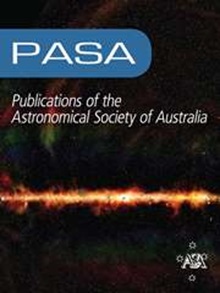EMU/GAMA: Radio detected galaxies are more obscured than optically selected galaxies
IF 4.6
3区 物理与天体物理
Q1 ASTRONOMY & ASTROPHYSICS
引用次数: 0
Abstract
We demonstrate the importance of radio selection in probing heavily obscured galaxy populations. We combine Evolutionary Map of the Universe (EMU) Early Science data in the Galaxy and Mass Assembly (GAMA) G23 field with the GAMA data, providing optical photometry and spectral line measurements, together withWide-field Infrared Survey Explorer (WISE) infrared (IR) photometry, providing IR luminosities and colours. We investigate the degree of obscuration in star forming galaxies, based on the Balmer decrement (BD), and explore how this trend varies, over a redshift range of 0 <EMU/GAMA:射电探测到的星系比光学选择的星系更模糊
我们证明了射电选择在探测严重遮挡星系群方面的重要性。我们将星系和质量集合(GAMA)G23 星场中的宇宙演化图(EMU)早期科学数据与 GAMA 数据结合起来,提供光学光度测量和光谱线测量结果,并结合宽视场红外巡天探测器(WISE)的红外光度测量,提供红外光度和颜色。我们根据巴尔默衰减(BD)研究了恒星形成星系的遮挡程度,并探讨了这种趋势在 0 < z < 0.345 的红移范围内的变化情况。我们证明,射电探测到的星系群的平均遮挡程度要比光学样本高,这是因为遗漏了BD最低、质量最小的星系,而这些星系也是恒星形成率(SFR)和金属性较低的星系。我们讨论了这一结果的可能解释,包括推测是否可能是由于低质量、低恒星形成率星系的恒星初始质量函数较陡造成的。
本文章由计算机程序翻译,如有差异,请以英文原文为准。
求助全文
约1分钟内获得全文
求助全文
来源期刊
CiteScore
5.90
自引率
9.50%
发文量
41
审稿时长
>12 weeks
期刊介绍:
Publications of the Astronomical Society of Australia (PASA) publishes new and significant research in astronomy and astrophysics. PASA covers a wide range of topics within astronomy, including multi-wavelength observations, theoretical modelling, computational astronomy and visualisation. PASA also maintains its heritage of publishing results on southern hemisphere astronomy and on astronomy with Australian facilities.
PASA publishes research papers, review papers and special series on topical issues, making use of expert international reviewers and an experienced Editorial Board. As an electronic-only journal, PASA publishes paper by paper, ensuring a rapid publication rate. There are no page charges. PASA''s Editorial Board approve a certain number of papers per year to be published Open Access without a publication fee.

 求助内容:
求助内容: 应助结果提醒方式:
应助结果提醒方式:


